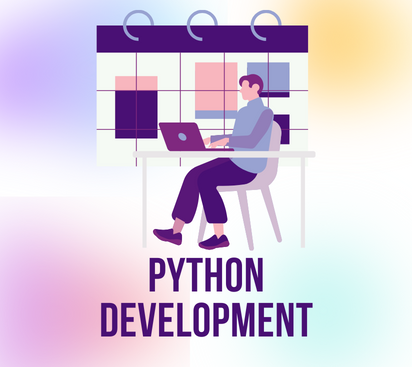

Short Overview
Python is a computer programming language often used to build websites and software, automate tasks, and conduct data analysis. Python is a general-purpose language, meaning it can be used to create a variety of different programs and isn't specialized for any specific problems.
- Necessity of Programming.
- What is Python?
- Why And Who Created It?
- What Python Can Do ?
- Why Should I learn Python?
- Important Features
- Version History
- Different Python Implementations.
- Downloading And Installing Python.
- Testing Python Installation.
- What is Python Shell?
- Using Python Shell.
- What Python Can Do ?
- Writing Python Script Using Notepad.
- Running Python Script.
- How To View The Bytecode File?
- Introduction To Predefined Functions And Mudules.
- How print() function work?
- How To Remove Newline From print()?
- Introduction To IDLE.
- Types Of Errors In Python.
- Rules For Identifiers.
- Python Reserved Words
- Basic Data Types In Python
- Some Very Important Points To Remember.
- Numeric Types.
- Converting Between Int Types.
- The Float Type.
- The Complex Type.
- The bool Type.
- The str Type.
- Concatenating Strings.
- The Slice Operator In Strings.
- Three Important String Function.
- Type conversion.
- How Variables In Python Are Different than Other Languages?
- Immutable And Mutable.
- Python's Memory Mangement.
- The id() and is() Function.
- How to write Comments in Python?
- How to create constants in Python?
- How to Print a variables value using print()?
- Types of Operators.
- Arithmetic operators.
- Special point about + and *
- Difference between / and //
- Relational Operators.
- Relational Operators With Strings.
- Chaining of Relational Operators.
- Special Behavior Of == and !=
- Logical Operators.
- How Logical Operators Work With Boolean Types?
- How Logical Operators Work With Non-Boolean Types?
- Assignment Operators.
- Various Types of Assignment Operators.
- Compound Operators.
- Identity Operators.
- Membership Operators.
- Precedence And Associativity.
- Using the Input() Function.
- Using the math Module.
- Different ways of importing a module
- Accepting multiple values in single-line.
- Using the eval() Function
- Using Command-line Arguments.
- Using format specifiers.
- Using the function format().
- The if Statement.
- Concept of Indentation.
- The if-else Statement.
- The if-elif-else Statement.
- What about ternary operator?
- Types of loop supported by Python.
- The while loop.
- The while-else loop.
- The break,continue and pass Statement.
- The for loopIntroduction to Pycharm
- Introduction to Pycharm IDE
- Downloading and Installing
- Developing Fist Application In Pycharm.
- What is a Function?
- Function v/s Method.
- Steps Required For Developing user Defined Function.
- Calling a Function
- Returning value form Function
- Arguments v/s Parameters
- Types Of Arguments
- Variable Scope.
- Global Scope.
- Variable Scope.
- Argument Passing.
- Anonymous Functions or Lambda Function
- The map() Function
- The filter () Function
- Using map() and filter() Lambda Expressions.
- What is a List?
- Creating a List.
- Accessing The List Elements
- Adding new Data In the List
- The Slice Operator With List
- Modifying A List
- Deletion In A List
- Appending / Prepending Item In a List
- Multiplying A List
- Membership Operators On List
- Built In Functions For List
- Method Of List
- List Comprehension
- What Is A Tuple?
- Differences With List
- Benefits Of Tuple
- Creating Tuple
- Packing / Unpacking A Tuple
- Accessing A Tuple
- Changing the Tuple
- Deleting the Tuple
- Functions Used With Tuple
- Method Used With Tuple
- Operations Allowed On Tuple
- What is A String?
- Creating A String
- Different Ways Of Accessing Strings
- Operators Which Work On Strings
- Built In String Functions
- Printing String using f-string
- Modifying Strings
- String Methods
- What is A Dictionary?
- What is key- value pair?
- Creating A Dictionary
- Important Characteristics Of A Dictionary
- Different Ways To Access A Dictionary
- Updating Elements In Dictionary
- Removing Elements From Dictionary
- Functions Used In Dictionary
- Dictionary Methods
- Dictionary Comprehension
- Restrictions On Keys
- Introduction To Exception handling
- Exception Handling Keywords
- Exception Handling Syntax
- Handling Multiple Exceptions
- Handling All Exceptions
- Using Exception Object
- Getting Details Of Exception
- Raising An Exception
- Using finally Block
- Creating user Defined Exceptions
- What is Operator Overloading
- How To Perform Operator Overloading
- List of Operator Which Can Be Overloaded
- Reverse Arithmetic Operators
- What is Data And Database?
- What is DBMS?
- What is SQL?
- How to configure our system for database programming.
- Introduction To SQLite
- Using Exception Object
- Steps Needed For Connecting To SQLite From Python
- Exploring Connection And Cursor Objects
- Executing the SQL Queries
- Different Ways of Fetching the Data
- Executing INSERT Command
- Executing Dynamic Queries
- Concept of Bind Variables
- Executing Update Command
- Executing Delete Command
- What is File Handling?
- What is the need of File Handling?
- Examples Where Files Are Used?
- Python's Way of handling Files
- Files Opening Modes
- Writing In A File
- Different Ways For Reading From File
- The seek() Method
- Appending in a File
- Using with statement
- What is module?
- Different ways of Importing Module
- The concept of the variable__name__
| Python Lecture 1 | Preview |
| Python Lecture 2 | Preview |
| Python Lecture 3 | Preview |
| Python Lecture 4 | Preview |
| Python Lecture 5 | Preview |
Basic to Advance
- Basic to Advance : Learn Python programming from basics to advanced concepts.
- Zero to Hero : Transform yourself from a beginner to an advanced coder.
- Data Types to Data Base : Cover a wide range of Python programming concepts, from data types to databases.
Live Lectures
- 80+ Hours : Attend live lectures and learn from the comfort of your home.
- Hands-on Practice : Get hands-on experience by practicing coding exercises during the lecture.
- Practice Session : Get dedicated practice sessions to revise and reinforce your learning.
Doubt Solving
- Unlimited Doubts Clearing Facility : Clear all your doubts with our dedicated faculty.
Test Series and Assignments
- Dedicated Test Series after Every Topic : Test your knowledge and progress with dedicated test series.
- Assignments : Practice coding exercises to reinforce your learning.
Notes of Every Lecture
- Dedicated Notes for Every Lecture : Get access to notes for every lecture.
Projects
- Live Projects to Practice Python Programming Concepts : Get hands-on experience by working on live projects.
- OOPs Concepts in Project : Learn how to apply Object-Oriented Programming (OOP) concepts in a practical setting.
- Best Industry Practices: Learn how to apply best industry practices to build the project.
Certifications
- Two Certificates After Completion of Project : Get two certificates after completing the Python programming course and the project.
- Python Completion Certificate : Get a certificate of completion for Python programming.
- Project Completion Certificate : Get a certificate of completion for the project.
Laptop / Computer Spefiications
- System With Minimum I3 Processor Or Better
- At Least 4 Gb Of Ram
Python Interpreter
Integrated Development Environment (IDE) or Text Editors
- Download PyCharm
- Download Visual Studio Code
- Install Jupyter via Anaconda
- Download Sublime Text
- Download Atom
Package Management
Version Control
Databases
Libraries and Frameworks
- NumPy Documentation
- Pandas Installation
- Matplotlib Installation
- Django Installation
- Flask Installation
- Requests Installation
- BeautifulSoup4 Installation
- Scrapy Installation
- Pytest Installation
Optional Tools
Documentation Tools
Ready to kick-start your career?
Join Us Now Join Us Now



